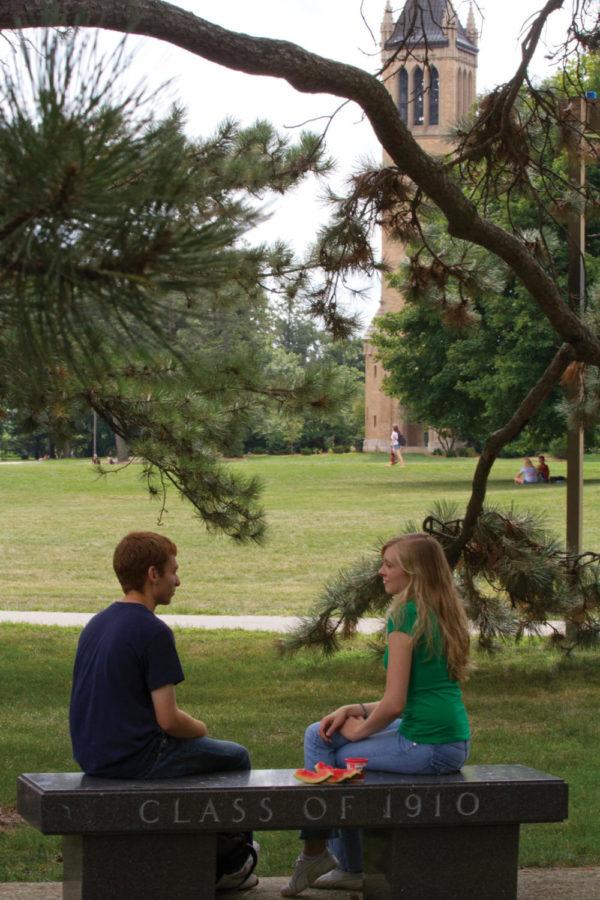Belding: Make more use of Central Campus’ margins
Photo: John Andrus/Iowa State Daily
Jackie Souleyrette, senior in biochemistry, sits and chats with Dylan Rivas, senior in biochemistry, on Central Campus on Monday.
September 27, 2011
Enclosure is the act of fencing off public lands, or commons. Historically it was most notably employed in England. English aristocrats increasingly used it beginning in the Elizabethan era and continued to do so throughout the 1600s and 1700s until lands that were formerly held in common by communities, available for use by everyone, were in the hands of private landowners.
As a result, peasants who were formerly independent became landless laborers, tenant farmers working for immensely propertied landowners. Enclosures have even migrated so far as to touch our campus here at Iowa State.
It’s fall. The leaves are changing their colors from vibrant greens to vivid reds and oranges as they die. The air feels more crisp. The sun shines consistently and the temperatures are comfortable. Being outside is probably one of the best ways to spend your time this month and next.
Dozens if not hundreds of students every day take the weather up on its offer of a sunny, crisp, colored afternoon. Many of them do so on Central Campus, that undeveloped expanse between Curtiss and Beardshear halls.
But technically, Central Campus extends from Union Drive in the south, across from the Memorial Union, on up to the steps leading into MacKay Hall on its north end. Most of that area is open. Most of it consists of that great unshaded expanse. Some of its best parts, though, lie elsewhere.
The trouble is getting to them. Chain-link fences abound, restricting our ability to just walk across the grass. I challenge you to not notice the difference between walking on a cement sidewalk (possibly being stuck behind a slow walker or struck by a cyclist) and cutting across grassy areas. I’m no fan of nature or camping, but even I love to avoid the sidewalks when it’s possible.
Between the Campanile and Union Drive is a largely fenced-off area. Fences run along the west sidewalk of Morrill Road. They divide parts of Central Campus near LeBaron and Catt halls, and are generally obstacles to free movement.
Having an uncultivated field smack in the middle of Ames is an immeasurable blessing. But Central Campus isn’t just that field. It’s so much more than that. It’s the space on the south end, in the shade of the Campanile and its trees. It’s the shaded area on the north end, where the benches donated by the class of 1910 sit. It’s the steps of MacKay and the other pool of water on campus.
The courtyards in Food Sciences or Lagomarcino Halls are not the only quiet outdoor spaces on campus.
Having a space for casual sports and athletic activity is good, especially in a world filled with junk food and health risks. Leading an active life is important, but contemplation and reflection are also important. We need spaces for them, too. Having accessible outdoor spaces for them is even more important.
Nature is powerful. Every year tornadoes, hurricanes, hailstorms, droughts and blizzards send the best-laid plans of mice and men awry. Every year people are brought to their knees by the power of phenomena that insurance companies still refer to as “acts of God.” Studying outside isn’t out of place. Nor should we do it simply because the fresh air helps us concentrate.
We should study outside from time to time, whether we study laboratory physics or intellectual history, because in doing so we become aware of the physical world around us, the world in which we live and die. When we understand how other living things act and move and grow and decay, we can adjust ourselves to those lessons accordingly.
But unless people go out and study nature, those lessons will never be taught. We will go through our lives with our highly cultivated ideas, but without connecting them to the ashes and dust from whence we came and to which we shall return.
We are not masters of the universe, though we daily congratulate ourselves as such. We think that since we have the power to destroy all life on this planet, the power to reason out complex math and science problems, and the power to use machines instead of our hands to do most of our work, we rule over it.
But we don’t. Until we regain the power to cultivate the earth’s resources moderately, with self-restraint — until we regain the power to conserve the earth — we are slaves to our own insatiable, base desires. Maybe you don’t want to hear any advice, but here it is: Step over the fences, and learn a little about something bigger than yourself.







